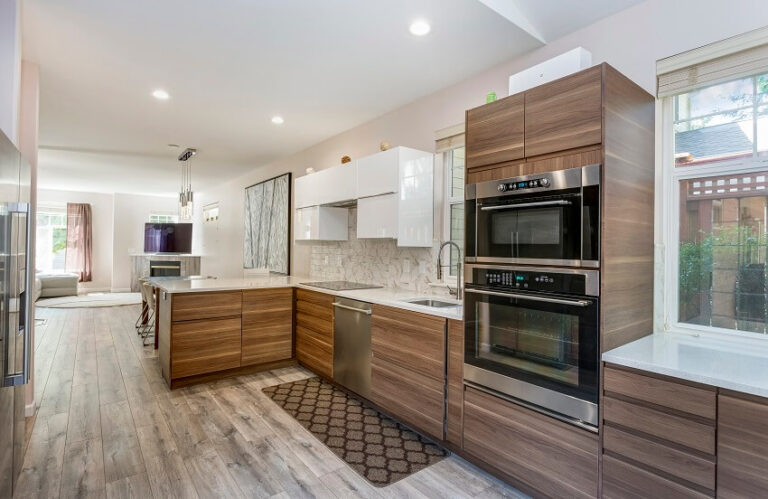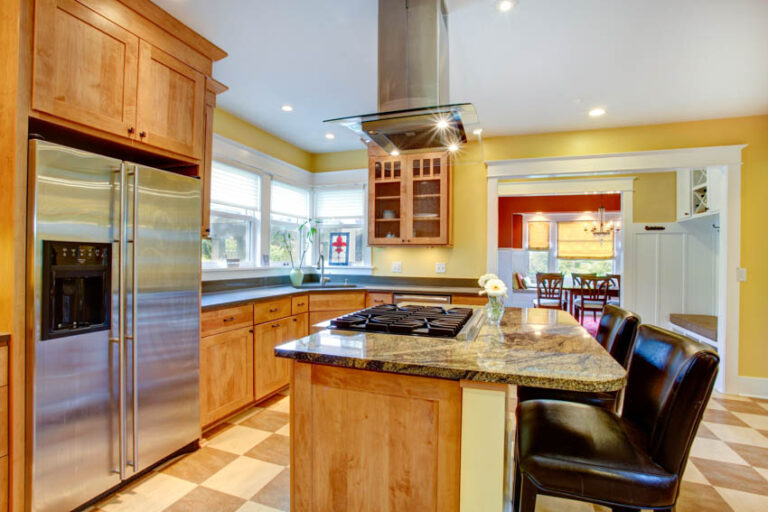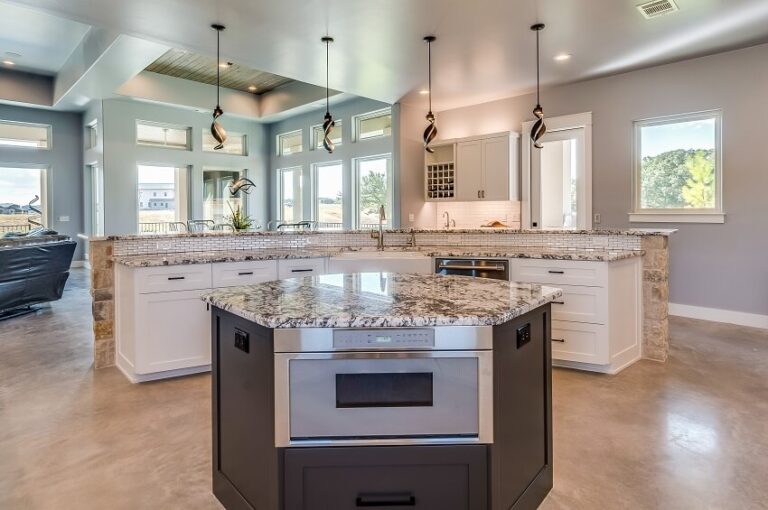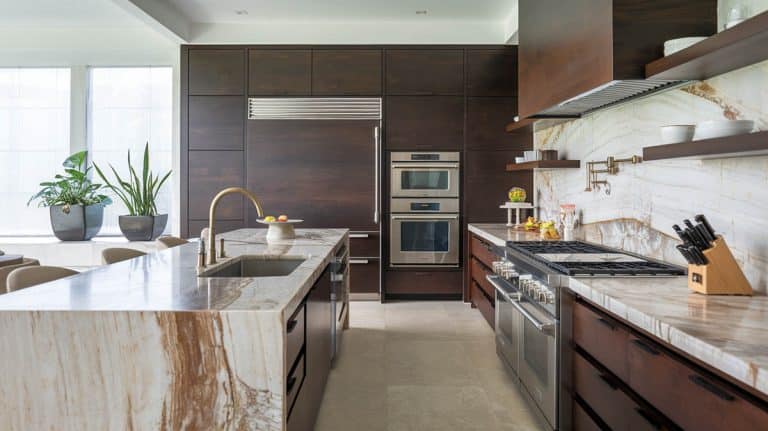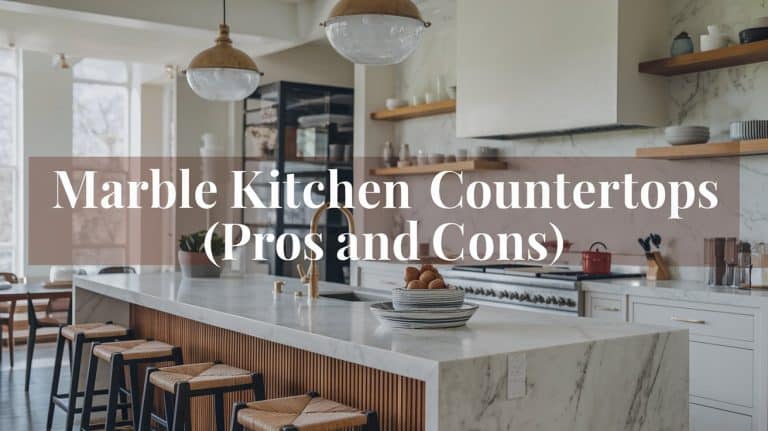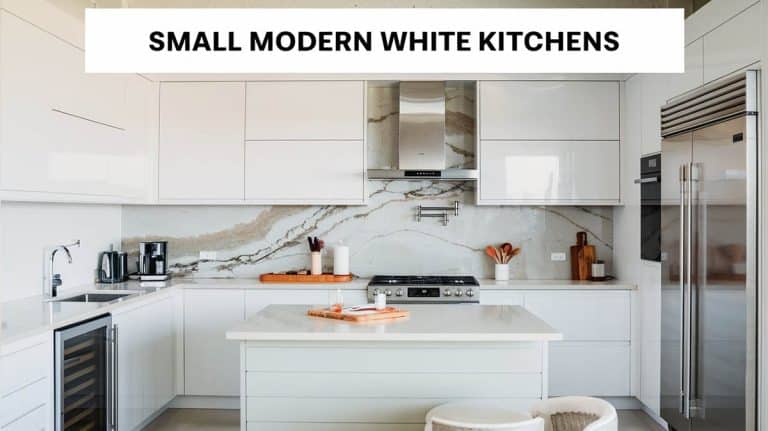Types of Cooktops (Ultimate Buying Guide)
Cooktops are stoves without the oven installed below them, adding versatility and freeing up space below the counter for cabinets or storage. If you’re considering a kitchen remodel, installing a cooktop instead of an oven and range combination has quite a few benefits. Let’s look at the different types of cooktops to help you find the right one.
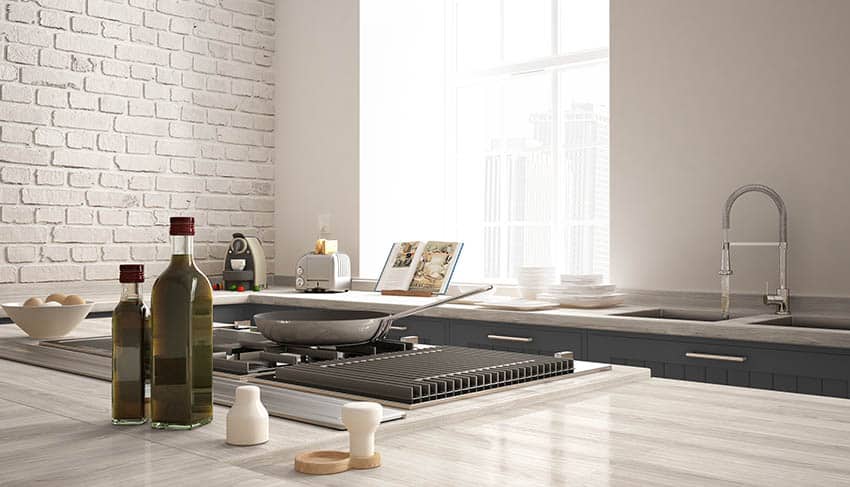
This guide explains the features and options available when purchasing a new cooktop for your kitchen to help you decide which one works for you.
Electric Cooktop

Electric cooktops are the most affordable and may be necessary for homes built in an area that does not have natural gas. Electricity runs through heating elements to warm up pots and pans and cook food.
They work best with flat-bottomed cookware that allows direct contact with the heat from the element, but pots or pans with ridges on the underside take more time to heat.
This type needs time to heat up and to cool down, affecting cooking times. An electric cooktop comes with coil burners or a smooth top and will likely raise your electricity bill.
Electric Coil Cooktop – They are the most affordable type with heat elements made of nickel-based nichrome. This coil or strip of thick wire gives off heat when electricity passes through it.
Coils are resilient, hard to damage, and last for many years. These can be tough to get clean, making regular cleaning a necessity.
The coils are easy to replace. If one dies, they pop out of their socket, and the new coil is easily installed in the socket.
Electric Smooth Top – Electric cooktops also come with a smooth surface. Smooth top electric cooktops use the same coils but they sit below a thick ceramic-top with an overlay of thick glass.
The coils heat the glass surface and show a small amount of the red, hot coil, which outlines where the burners are. These can sit flush with the counter and blend into the kitchen’s design.
Smooth tops are easier to keep clean without crevices and places for grease and food to build up.
Gas Cooktop

These cost less to run than electric and have options such as a vast range of heat and temperatures, and almost any type of pots and pans can be used.
Be sure the gas cooktop you purchase has an automatic shut-off if the flame goes out to prevent gas leakage. They are generally more budget-friendly on monthly utility bills than electric or induction.
Induction Cooktop
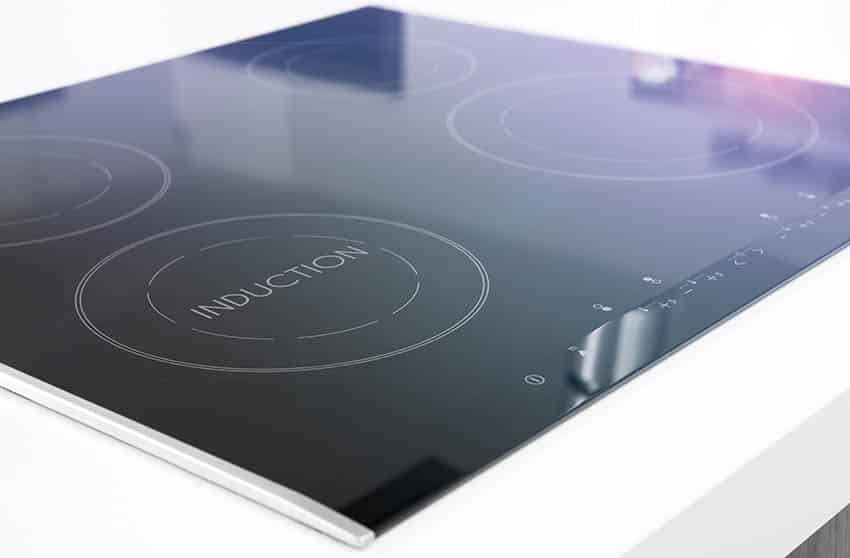
Induction cooktops have a smooth glass surface similar to smooth electric models but work very differently. They use special elements that create a magnetic field.
This particular coil type heats pots and pans made of induction-compatible iron that produces heat by reacting to the magnetic field. Only induction cookware will heat up on these cooktops.
Objects, including children’s fingers, not made for induction burners will not heat up or burn. These heat quickly and provide precise temperatures. Food cooks evenly, and such units are energy-efficient.
Modular Cooktop
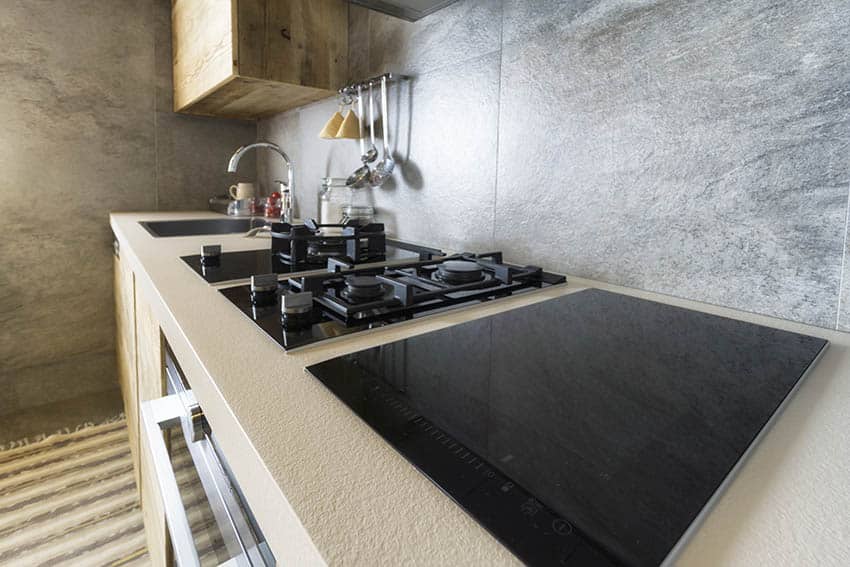
Modular cooktops are custom designed in many configurations. When purchasing a modular cooktop, you have the choice to combine cooking elements as individual burners such as electric with induction, gas with electric, and whatever combination works best for you.
The burners are designed in different configurations according to their use. If you enjoy year-round grilling, combine an indoor grill that uses gas with electric coil burners to the side of it.
Place a deep fryer in the middle of the cooktop with gas burners on both sides or add a steamer module. These modular types come with an option for downdraft ventilation, so a hood is not needed.
Cooktop Surfaces
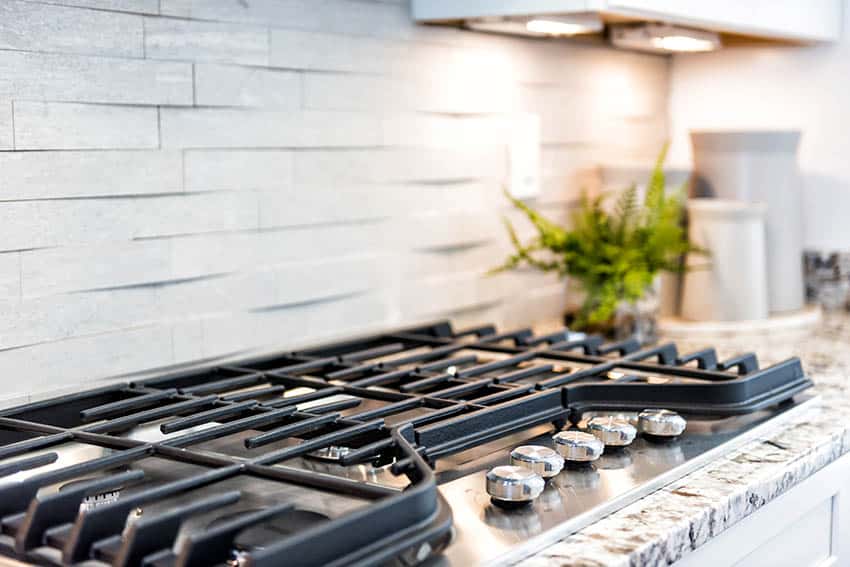
Although smooth surface cooktops with sealed burners are associated with electric and induction cooktops, they are used with gas cookers. The advancement and technology of today allow manufacturers to create more efficient models combined with elegant designs.
Except for stainless steel, stovetop surfaces come in common colors such as black, white, and bisque. Electric ceramic cooktops come in the same colors, plus a pure white, which is a bright, white glass. Their surfaces are either framed with trim on all four sides or unframed.
Manufacturers are changing and adding many colors and styles for stovetop surfaces depending on the materials they’re made from. There are quite a few finishes available, whether you want to match the current surfaces in the kitchen or change the look and feel for a fresh makeover.
Stainless Steel Cooktop
Although stainless steel cooktops are stunning, they aren’t as easy to clean as ceramic and require regular maintenance. Wipe off any spills or burned on food right away and use special cleaners meant for stainless steel.
Ceramic Stovetop
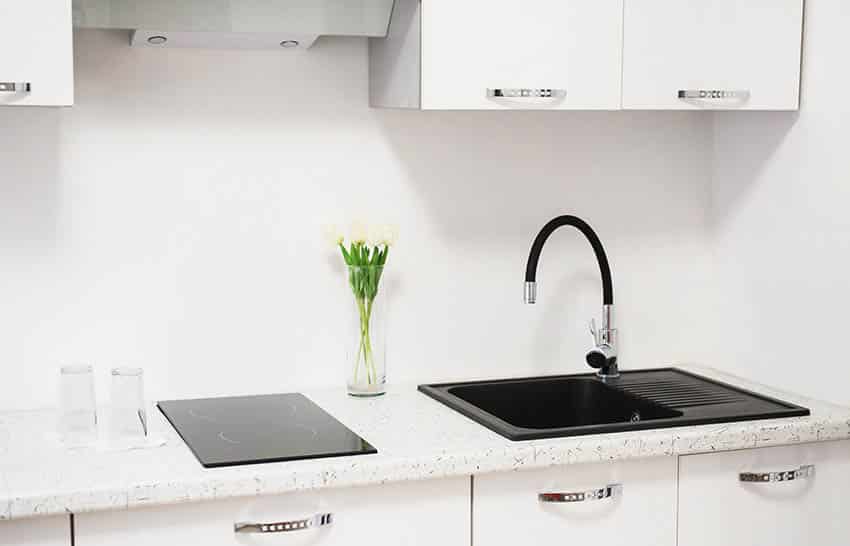
Ceramic cooktops are appealing for their sleek design and are easy to clean. When counters are cluttered with recipe ingredients and the cooktop is not being used, the ceramic surface makes a convenient spot to place ingredients.
These do scratch easily. It’s suggested not to use ceramic surfaces for cutting, place heavy kitchen items on them, or put hot items on the surface.
Glass Ceramic Cooktops
Glass ceramic cooktops are a type of stove that has a smooth, flat surface that’s easy to clean. However, similar to ceramic models, they send to scratch easily.
Most glass ceramic models use radiant heating elements that are located beneath the glass surface. These elements heat up and transfer heat to the cookware placed on top.
Some glass ceramic unit are induction-based, which means they use electromagnetic fields to directly heat ferromagnetic cookware. Induction units are more energy-efficient and offer quicker heat response than traditional radiant systems.
Porcelain Cooktop
The porcelain surface cooktops are stain-resistant, heat-resistant, and do not scratch as much as glass ceramic moels. They clean up easily and do not require as much maintenance. They are susceptible to damage if heavy objects are dropped on them.
Enamel Cooktop
Enamel cooktops are kitchen appliances that feature a cooking surface coated with enamel, a type of glass fused to a substrate material at high temperatures.
These models are easy to clean and look beautiful, but they break easily when not handled gently, even though they appear to be durable.
Glass Cooktop
These modern glass cooktops have a fashionable look, but they scratch easily. Glass surfaces break when force is used or a heavy item drops on the surface.
Number of Cooktop Burners
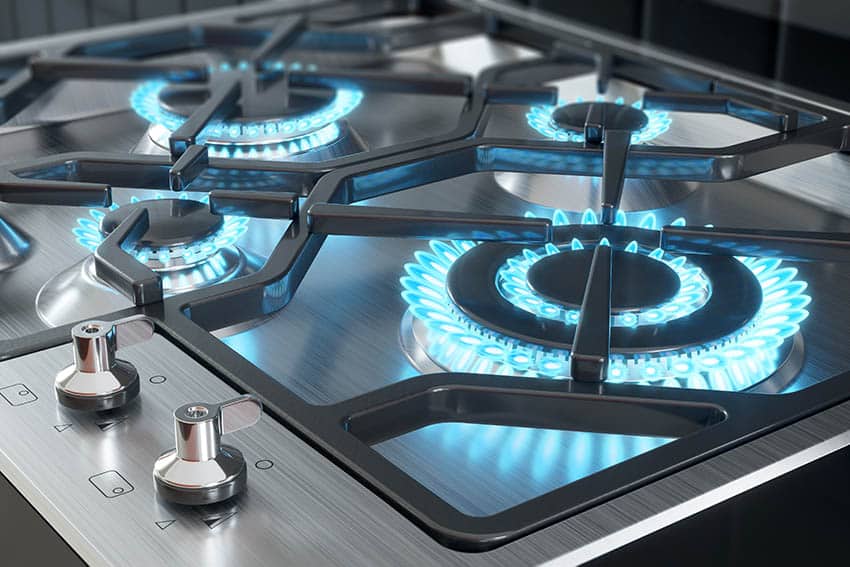
Cooktops are generally anywhere from 12 to 30 inches, with larger styles being 36 to 40 inches.
The size and type of cooktop determine how many burners it can accommodate. Modular units that include a grill or steamer plus burners need a layout that fits all the elements within the space.
30-inch cooktops can accommodate four burners, and 36-inch cooktops can fit five burners, six burners, or four burners, and an extra module such as a grill, steamer, deep fryer, or wok.
Cooktops that include one type of burner, such as an electric coil model, may have four to six burners depending on the size and space allowed, including room needed for the knobs and controls.
If you cook often or make meals for large groups, and want one with the most burners may mean choosing an electric smooth cooktop.
The burners underneath the solid surface are either single, double, or triple-tiered to allow for different-sized pots and pans without being limited to one size coil burner. Lines on the glass surface outline the sizes of the burners.
Another option when limited to how many burners are included with the cooktop is to incorporate bridge elements. Bridge elements are extenders that sit between two burners, used to rest oblong or oversized pots and pans on the surface.
Cooktop Features
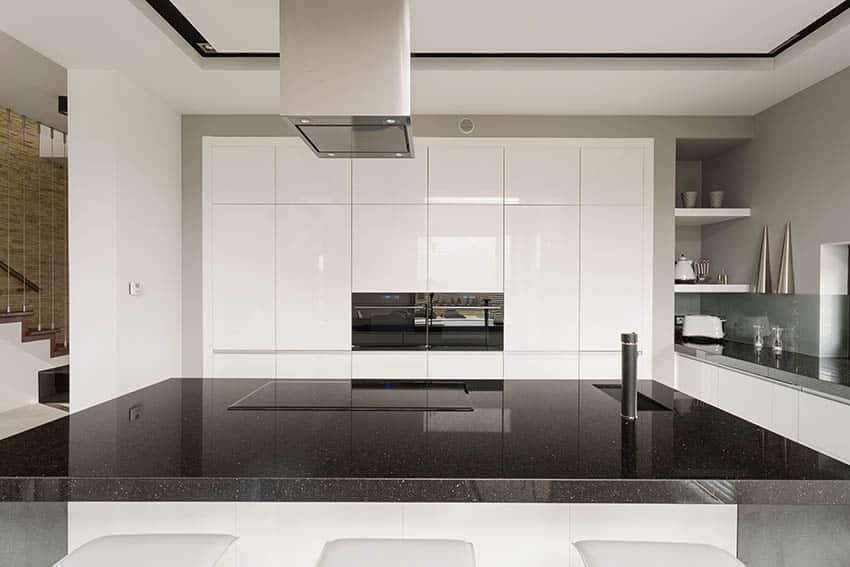
A number of features allow the homeowner to purchase a cooker that meets all their cooking needs. Options include high-heat burners, digital controls, and various modules. Below are some of the more popular features consumers choose.
Downdraft Extractor
In order to have the freedom to place a stovetop on any kitchen surface, a downdraft extractor eliminates the need for a range hood.
The downdraft pulls air across the top of the cooktop moving smoke, grease, and steam down through a filter under the cooktop. An attached duct carries the air under the floor or along a cabinet kick space, venting it outside the home.
Overhead Hood
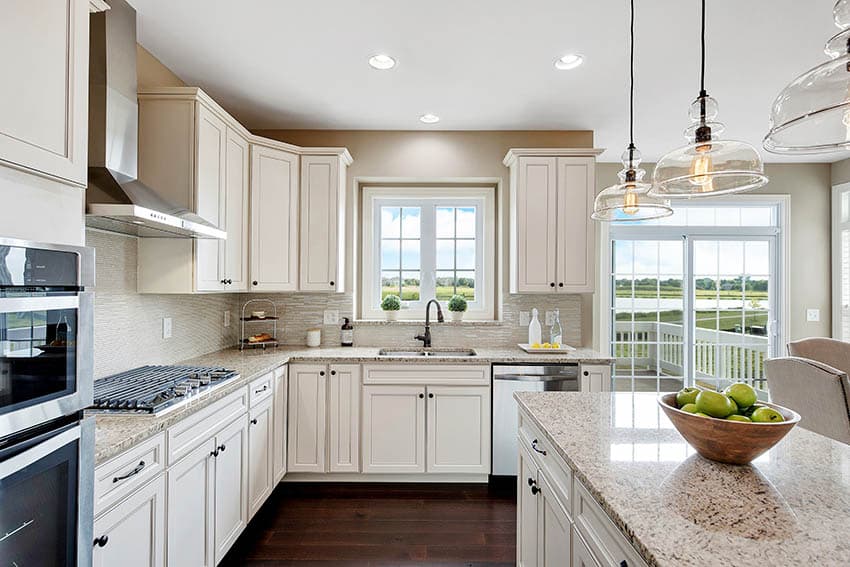
An overhead hood is needed to vent smoke, grease, steam, and smells when a stovetop cannot accommodate a downdraft extractor. Hoods come in various sizes, shapes, colors, and materials.
If the range top is a focal point in the kitchen, a larger, more cosmetically designed hood enhances the space while providing proper venting.
LED Display
A stovetop with an LED display is helpful for the busy cook. While an LED display doesn’t change the capabilities of the cooktop, it provides important information when cooking.
Some of the information displayed includes the time, time left on the timer, temperature, and if the convection fan is running. The information provided on the LED display varies by appliance type and manufacturer.
Portable
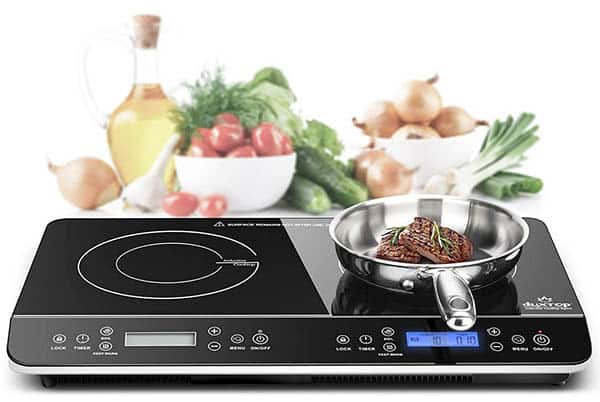
Cooktops are commonly larger, multi-functional appliances that are installed on a kitchen surface, such as a countertop or kitchen island.
However, when preparing for a large event means the need for more range top space, portable cooktops are a great option.
These types of cooktops do not get installed in a countertop or other surfaces. They’re single units are easily moved around the kitchen, used for outdoor patio grilling, and make a convenient appliance for a kitchenette. Portable cooktops have only one or two burners and are electric coil or induction.
Power Burners
Most cooktops have three different size burners; a small burner for simmering, a medium burner for everyday cooking, and a large burner known as a power burner providing the most heat.
Most have power burners with controls that designate a setting to provide rapid boil for boiling water quickly. Power burners are great for kitchen tasks such as heating soup quickly, searing meat, or heating a wok to make stir fry.
Seamless Grates
Seamless grates are one complete piece covering the entire cooktop surface area. By having one grate, it’s easier to slide a large, heavy pot or pan across to one side of the range top. This one-piece grate style looks professional and modern while making it easy to move heavy cookware on the grate.
Grates are commonly made with one of several materials, cast iron, metal, or ceramic-coated metals to allow easy cleanup.
Single grates move at times and can slant, putting the cook at risk of injury by spilling very hot liquids and foods on themselves.
Seamless grates are heavier because they are one-piece, but many homeowners find the ease of cooking and stylistic look worth the inconvenience.
Stove Griddles
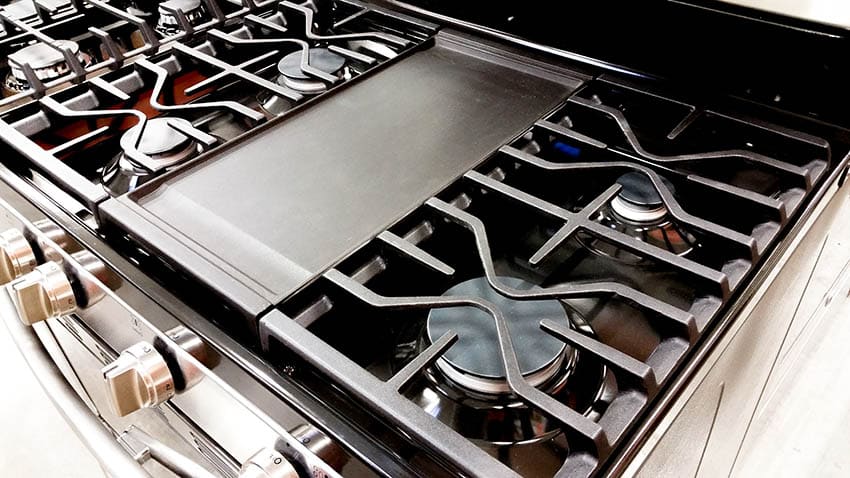
Some types of cooktops provide space for a griddle, typically in the center, which makes it easy to cook pancakes, French toast, and other foods typically cooked in a pan.
These include configurations such as a gas griddle on one side of the surface with burners in the rest of the space. These stove griddles can be removed for easy cleanup and usually have a small channel around the edges for catching grease and liquids.
Simmer Burners
Simmer burners are smaller burners to cook delicate foods that may burn quickly. Sauces, puddings, thick soups, and chocolate need a low-flame or low heat and a longer cooking time.
These simmer burners are usually at the back of the rangetop as they don’t need to be checked as often. Simmer burners can also be used to keep food warm and go as low as 140 degrees.
Automatic Ignition
Gas cooktops with automatic ignition are lit by turning the knob on the cooktop, which allows the flow of gas, and triggers an electrical spark to ignite the gas burner. The flame is then adjusted with the knob, marked with several settings such as low, medium, and high.
The cooktop requires electricity to create the spark but some use batteries, which have to be replaced periodically. Automatic ignition is safer compared to manual ignition using a matchstick or lighter, which causes the gas to enter the air in the kitchen each time a burner is ignited.
Wi-Fi
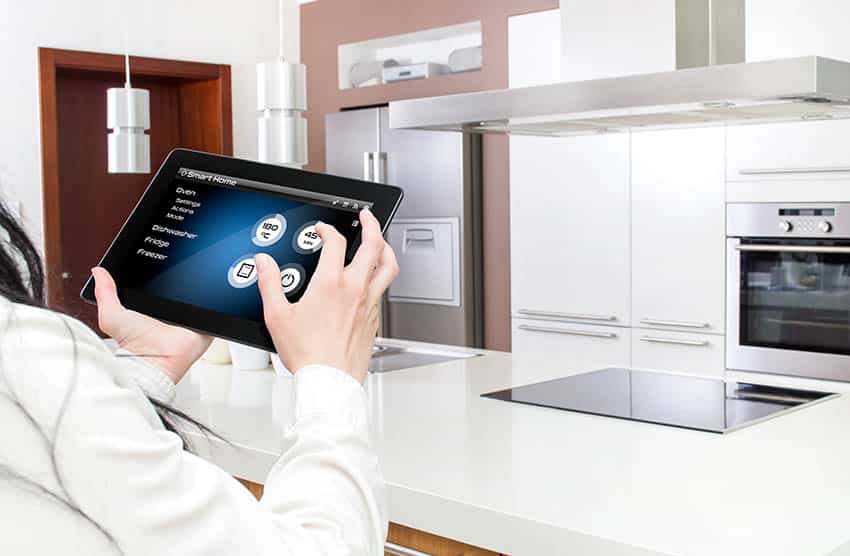
Smart cooktops are Wi-Fi enabled and controlled with a smartphone or tablet app. This smart technology makes cooking simpler, faster, and safer by letting the cook control the cooktop remotely.
Such units may include app functions such as setting a timer, adjusting the temperature of the burners, and notifications if a burner is left on. Some Wi-Fi cooktops have voice commands and work with smart home devices such as Amazon Echo and Google Home.
While these features make it easy to control the cooktop without getting up and down or from another room, care needs to be taken that the convenience of Wi-Fi controls do not cause the user to leave the cooktop unattended too long.
Digital Touch
Digital touchpad controls are panels with a display allowing the cook to easily touch the surface and choose temperatures and other options.
On a smooth electric stovetop, they are located under the glass top and continue the sleek look of the surface. There are no knobs to trap dirt and grease, making them hard to clean, and touchpad controls are more precise.
Two types of digital touch controls are available. Touch controls that are pressed to operate and digital touch controls with a surface that senses warmth from the user’s finger, needing as little pressure as a touch-sensitive computer screen.
Stovetop Safety Features

The different types of cooktops include a variety of safety features depending on what type of heating element they use and what the fuel source is.
These safety features are important and prevent accidents and injuries. Cooktops already provide child safety due to their placement on counters, with the controls out of reach of small fingers.
stovetop safety features also vary by the manufacturer, with some mandated by appliance safety regulations.
• Gas cooktops may incite concern for homeowners who worry about pilot lights and gas leaks from flames under a burner going out. A draft from an open window or the breeze from a fan nearby could cause the gas burner flame to go out, especially if the flame is very low.
The gas stovetop has a sensor to detect the flame is out and automatically ignites the burner. These also have a safety valve for the gas supply line to regulate the flow of gas.
• Electric coil cooktops now include temperature-limiting features to reduce the risk of fire from oil in a pan or unattended pots with food in them that begin to burn.
Beginning in September 2019, the Underwriter Laboratories (UL) updated standard 858, requiring all coil top ranges to have temperature-limiting capabilities to reduce the risk of stovetop oil and grease fires.
As a result, electric coil burners now come with Sensi-Temp Technology. These coils have a sensor in the middle of the coil that shuts the burner off if the temperature nears 450 degrees. Once the coil reaches a safe temperature, the burner is turned back on.
• Electric smooth cooktops include a hot surface indicator light to alert the cook or other people in the kitchen that the surface is still hot even though it’s been turned off. The surface needs time to cool down.
• Induction cooktops only react with ferrous iron cookware, meaning they are not hot to the touch. If a small child places their hand on the induction burner’s surface, they will not get burned.
These automatically shut off is no induction cookware on the burner, and most have a maximum cooking time, normally 12 hours, when the burner turns off.
If vent holes in the stovetop are blocked, the extreme heat produced will also cause the burner to turn off, preventing a fire.
• Many types of cooktops with knobs include a feature that causes the knob to light up when the stove is on. The lighted knob prevents the cook from leaving a burner on and provides an attractive design feature, especially at night.
• Digital cooktops typically include lockout controls so the cook can prevent a child who reaches the stovetop control panel can’t turn it on.
Now that you have information on the types of cooktops and their many features and configurations, it will be easier to decide on the right one for your new kitchen or kitchen remodel.
Why Choose A Cooktop vs A Range
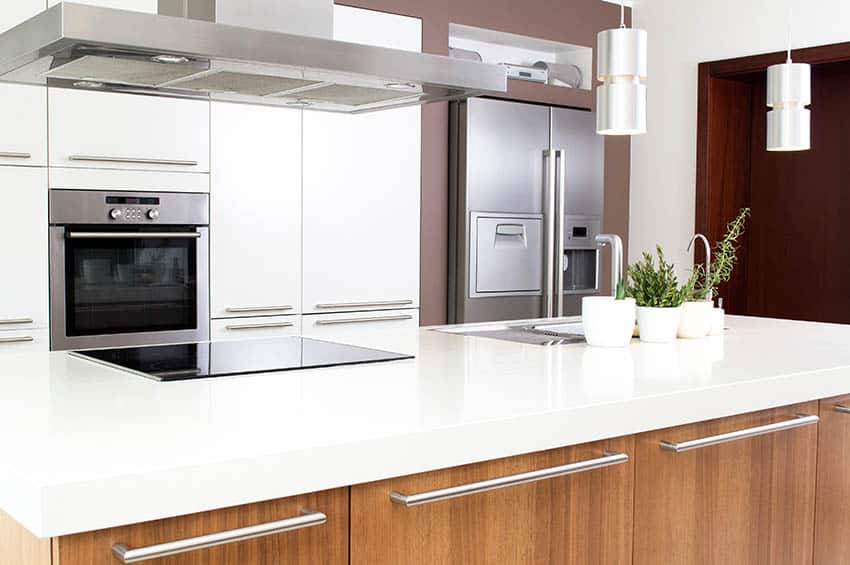
A kitchen needs good flow and ample space for working. The space should also allow an area for relaxing, entertaining, and storage. Below are some benefits of a cooktop versus a range with an attached oven.
• Kitchen storage is premium. A cooktop frees space and, when paired with a wall oven, provides a better-functioning kitchen.
• Cooktops offer more design options than a range. Placing the cooktop where it works best for the cook, such as near the food preparation area or installed on a kitchen island, adds convenience and allows for aesthetic features not available on a range.
• Creates less heat. When the oven is mounted on a wall or another place in the kitchen, less heat is generated in one area. For cooks who may stand at the range for long periods, a cooktop prevents extra heat from the oven, making it uncomfortably warm.
• Allows more storage. A cooktop allows storage or cabinets under the counter to store pots, pans, and baking dishes, or other kitchen utensils and small appliances.
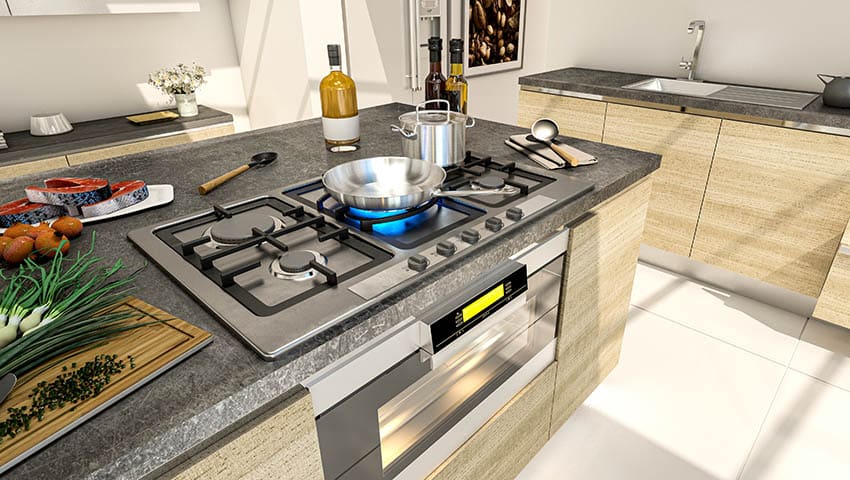
• Safer. Cooktops are safer when small children live in the home. The knobs and controls are on the top of the counter where the appliance sits, making it too high for toddlers to reach. The controls usually sit further back from the front edge of the countertop or kitchen island, making it harder to know it’s there.
• Customized to your specifications. Cooktops come with a choice of burner’s size and placement. (modular units) This allows the cook in the home to customize their cooking space. Read more about stove sizes here.
• Allows separation from the range. Using a cooktop separate from an oven allows two cooks to be in the kitchen without getting in the way of each other. One may be frying up chicken on the burner while the other is baking fresh bread in the oven.
Better kitchen work zone. Purchasing a cooktop instead of a range with an oven may end up being more expensive, but keeping these kitchen appliances separate offers many advantages. Remodeling allows you to create a more functional, easier-to-navigate kitchen and promotes an effective work zone.

